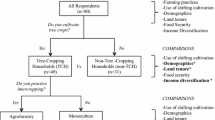Abstract
The potential effects of agroforestry systems on conservation and development have been well documented. Panama has seen a substantial rise in the number of projects with an agroforestry component in the 1990s. There has been insufficient research on the actual impacts of these projects on smallholders and of farmers' attitudes towards these systems. This study explores the perceived socioeconomic and environmental impacts of five agroforestry projects in Panama. A total of 68 smallholders were administered semi-structured interviews. In addition, 13 agroforestry experts from NGOs, government departments and research institutes were interviewed, and their responses were compared with those of the smallholders. While the projects led to an increase in the standard of living by providing wood products and fruit for domestic consumption, farm income levels generally remained unchanged. This was due primarily to limited market development, the lack of marketing organizations and poor access roads. In terms of environmental impacts, the farmers' responses suggested a slight decline in slash-and-burn agriculture, and an increase in tree planting activities. Some environmental benefits were observed by farmers, including reduced soil erosion, increased soil fertility, and improved quality and quantity of water sources. Nevertheless, slash-and-burn agriculture was still the norm for the majority of farmers. Most farmers continued to harvest wood from primary and secondary growth to meet their domestic wood requirements, rather than relying on trees planted in agroforestry projects. The main obstacles preventing increased agroforestry adoption included insufficient agroforestry extension, inappropriate project design or management (such as top-down management approaches, and the use of food incentives), smallholders' economic constraints, and larger policy issues. Recommendations are proposed to improve project design and management, and to address the economic and policy constraints.
Similar content being viewed by others
References
Budowski G (1993) The scope and potential of agroforestry in Central America. Agroforestry Systems 23: 121-131
Cannon PG and Galloway GE (1995) Fostering regional unity: The Madaleña Project of Central America. Journal of Forestry 93(10): 32-35
Chambers R (1991) Shortcut and participatory methods for gaining social information for projects. In: Cernea M (ed) Putting People First: Sociological Variables in Rural Development (pp 515-537). Oxford, UK: Oxford University Press
Chew S (1989) Agroforestry Projects for Small Farmers: A Project Manager's Reference. Washington, DC: US Agency for International Development
Chiong-Javier E and Sembrano JO (1988) Developing People-oriented Agroforestry. Manila, Phillipines: De La Salle University Press
Current D, Lutz E and Scherr SJ (1995) Adopcion Agrícola y Beneficios Económicos de la Agroforestería: Experiencia en América Central y el Caribe. Turrialba, Costa Rica: CATIE. World Bank Environmental Paper 14, 420 pp
Current D and Scherr SJ (1995) Farmer costs and benefits from agroforestry and farm forestry projects in Central America and the Caribbean: implications for policy. Agroforestry Systems 30: 87-103
De la Cruz RE and Vergara NT (1987) Protective and ameliorative roles of agroforestry: an overview. In: Vergara NT and Briones ND (eds) Agroforestry in the Humid Tropics (pp 3-30). Honolulu, Hawaii: Environment and Policy Institute, Southeast Asian Regional Center for Graduate Study
Elton C (ed) (1997) Panamá: Evaluación de la Sostenibilidad Nacional. Panama City: Centro de Estudios y Acción Social Panameño
Fischer AA (1998) Integrating Rural Development and Conservation: the Impacts of Agroforestry Projects on Small Farmers in Panama. M.E.S. Thesis, Dalhousie University, Halifax
Fisher L and Bunch R (1996) Challenges in promoting forest patches in rural development efforts. In: Schelhas J (ed) Forest Patches in Tropical Landscapes. Washington, DC: Island Press
facts/ag_facts.htm basics
INRENARE (1995) Informe de Cobertura Boscosa 1992. Panamá: INRENARE
Johnson DV (ed) (1991) Proceedings of the Humid Tropical Lowlands Conference: Development Strategies and Natural Resource Management. 17-21 June 1991. Maryland: Development Strategies for Fragile Lands, Panama City, Panama
Kapp G (Accessed March 1998) 'Farm Forestry and Agroforestry in Central America. Book Review'. http://omnibus.uni-freiburg.de/~gkapp/prod.htm
Legislative Assembly of Panama (1993) Ley 24 Reglamentación. Incentivos a la Reforestación. Decreto Ejecutivo No. 89 (de 8 de junio de 1993) Por el cual se reglamenta la ley No. 24 de 23 de noviembre de 1992
Magellan Geografix (accessed July 2001) Map of Panama. http://www.cnn.com/travel/city.guides/world/Americas/panama/map.html
Marmillod A (1989). Actitudes de los Finqueros Hacía los Arboles. In: Beer JW, Fassbender HW and Heweldop J (eds) Avances en la Investigación Agroforestal: Memoria del Seminario (pp 294-307). 1 a 11 de septiembre de 1985. Turrialba, Costa Rica: CATIE
McKay A (1990) Geografía de Panamá. Panamá: Universidad de Panamá
Muschler RG and Bonnemann A (1997) Potentials and limi-tations of agroforestry for changing land-use in the tropics: experiences from Central America. Forest Ecology and Management 91: 61-73
Nair PKR (1990) The Prospects for Agroforestry in the Tropics. World Bank Technical Paper No. 131. Washington, DC: World Bank
Nair PKR (1998) Directions in tropical agroforestry research: past, present and future. Agroforestry Systems 38: 223-245
Raintree JB (1989) Factores que Afectan la Adopción de Innovaciones Agroforestales por Agricultores Tradicionales. In: Beer JW, Fassbender HW and Heweldop J (eds) Avances en la Investigación Agroforestal: Memoria del Seminario (pp 307-319). 1-11 September 1985. Turrialba, Costa Rica: CATIE
Salas, F (1993) Fincas Demostrativas: Una Alternativa para Evaluar y Promover el Cultivo de Arboles de Uso MÚltiple. Revista Forestal Centroamericana 3(10): 39-41
Wiersum KF (1989) Significado de la Organización Social y de las Actitudes Culturales en el Desarrollo Agroforestal. In Beer JW, Fassbender HW and Heweldop J (eds) Avances en la Investigación Agroforestal: Memoria del Seminario (pp 26-39). 1 a 11 de septiembre de 1985. Turrialba, Costa Rica: CATIE
Winterbottom R and Hazelwood PT (1987) Agroforestry and sustainable development: making the connection. Ambio 16(2-3): 100-110
Author information
Authors and Affiliations
Rights and permissions
About this article
Cite this article
Fischer, A., Vasseur, L. Smallholder perceptions of agroforestry projects in Panama. Agroforestry Systems 54, 103–113 (2002). https://doi.org/10.1023/A:1015047404867
Issue Date:
DOI: https://doi.org/10.1023/A:1015047404867




